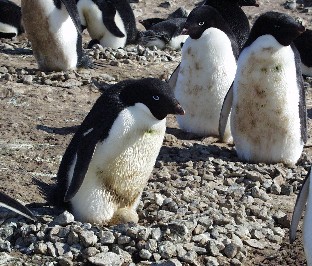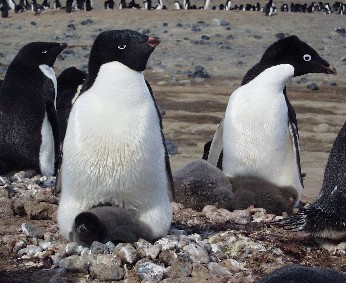Reproduction
Males attract a
mate with a “salute”, in which they stand a little over 10 feet
away from a female that they are interested, thrust their beak
and arch their neck to reach their full height.
This “salute” also establishes a male’s territory in the
colony. Once mating
pairs have been formed, the pair travels to the mating grounds.
The male arrives first to
claim their mating site.
They will exhibit territorial behavior by pecking their
beaks and yelling at any who challenge their dominion.
The male will call to his partner, a call which the
female is able to distinguish among the other male calls and
will make her way to their nest.
Couples usually keep the same nesting sites year after
year unless one fails to return.
Adélie penguins breed once a year, starting in early spring and continue into the summer months. This is due to the lengthening of days, which trigger the progression into a period of hyperphagia (feeding constantly to store fat that they need during the breeding and incubation periods.) A nest of pebbles is made in preparation for the offspring; the nest is built on sloping ice-free ground composed of pebbles to help avoid problems with snow and melting water. On average each couple will lay two eggs per season, one shortly after the other. An egg is incubation for about a month; during this period parents will take turns caring for the egg(s)while the other feeds.
Once the chick is
hatched the parents take turns searching for food, which they
will consume and
store, regurgitating it later to feed their young.
Around a month after the
chicks are hatched they will
join a
crèche
(a
group of young
Adélie
penguins that congregate for protections); during this
period the adolescent Adélies are still dependent on their
parents for food.
After about two months of being in a crèche, members will be
able to survive independently.
Young Adélies’ first visit to the breeding colonies is meant for them to claim a nesting site; this trip usually takes place between ages of two to four years. The majority of Adélies exhibit a natal philopatry tendency (return to their where they were born to breed for the first time; nest near where they were born). Adélies reach reproductive maturity at three to six years of age, females usually maturing faster than males. Those who breed at a younger age in general have a lower survivorship but tend to breed more successfully in their later years that those who begin mating later. Adélies can live up to sixteen years of age.